Proper back training begins with the exercises you choose to help you pursue your fitness goals. Commonly regarded as “pulling movements,” there are more viable back-training options than there are muscles in your back in the first place.
If your back workouts aren’t yielding you any gains or feel stale, chances are you just haven’t found the right movement — yet. Here are the 12 best exercises for back training and back-focused workouts.
Recent Updates: BarBend’s former Director of Content, Andrew Gutman, updated this article to improve readability. Senior Writer Jake Dickson revised the list of exercises and included expert testimony throughout the piece.
We made these adjustments in accordance with BarBend’s exercise selection methodology — which focuses on science-based evidence, user intent, and expert input. Other notable updates include adding movement modifications to each exercise, illustrating our anatomy section, and including workouts utilizing the exercises on this page.
12 Best Back Exercises
- Deadlift
- Pull-Up
- Bent-Over Barbell Row
- Chest-Supported Row
- Dumbbell Row
- Lat Pulldown
- Seated Cable Row
- Straight-Arm Pulldown
- Face Pull
- Back Extension
- Dumbbell Pullover
- Renegade Row
What Muscles Make Up the Back

[Read More: The Anatomy of Your Back Muscles, Explained (and How to Train Them)]
- Latissimus Dorsi: During back movements, the lats play many roles — most notably stabilizing the pelvis and interacting with the abdominal muscles in everything from respiration, maintaining shoulder positioning, to protecting the spine. (1)
- Teres Major: The teres major attaches next to the lat on the upper arm and stretches across to the lower part of the scapula. This muscle shares many roles with the muscles of the rotator cuff when it comes to shoulder stabilization. (2)
- Trapezius: The trapezius, or traps, is a large trapezoid-shaped muscle that spans across the better part of your upper and mid-back. Each of the divisions of the traps is hard at work during pulling movements to help maintain tension and stability in the back. (3)
- Rhomboids: The rhomboids — both major and minor — are positioned directly below the traps in the middle of the back (between the shoulder blades). These muscles retract, elevate, and rotate the scapula. Weakness or loss of function of the rhomboids can be a major contributing factor to a winged scapula, which makes it even more important to keep them strong. (4)
- Rear Delts: The rear delts are not usually categorized as back muscles. That said, the rear delt’s primary function is to bring the arm back around the body (shoulder extension), assisting the lats and teres major. (5)
- Erector Spinae: These deep muscles are responsible for controlling the axial skeleton — which includes the skull, vertebral column, and ribs — and have a primary function of flexion/extension, side bending, and rotation of the spine. (6)
1. Deadlift
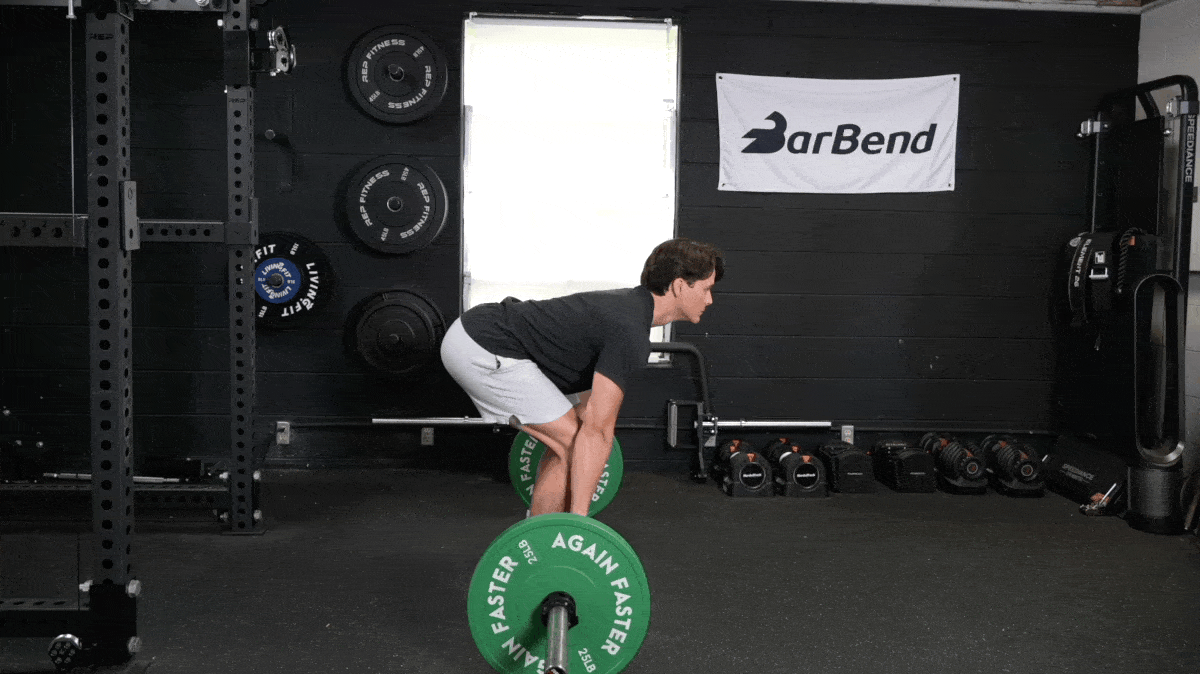
[Read More: The Single-Leg Deadlift Is the Best Pulling Accessory You’re Not Doing]
| Equipment Needed | Barbell, weight plates, barbell collars |
| Muscles Worked | Glutes, hamstrings, back, traps |
| Sets & Reps | 3 x 5 |
The deadlift is one of the best compound exercises you can do to add serious amounts of strength and muscle mass to your back. Although your back muscles do not contribute directly to the range of motion of the deadlift, their involvement is paramount for keeping your spine safe and holding the loads necessary for growth.
“Deadlifts don’t train your upper back as well as more specific movements do, but everyone should perform some form of deadlift on a regular basis,” Dickson recommends. “Properly picking up a weight from the floor is an essential movement pattern for everyday life.”
My recommendation is to prioritize deadlifts as one of the first few compound movements completed regardless of what body part you’re focusing on – whether a back, lower body, or total body day,” says Masi.
How To Do It
- Stand in front of a loaded barbell with your feet shoulder-width apart, hips back, and back flat.
- The knees should be bent slightly to allow you to grip the bar tightly, slightly wider than shoulder-width.
- Keeping your back flat and chest up, tighten the back muscles, and straighten your arms as you load the pull.
- With everything locked, aggressively push your legs into the floor as you simultaneously pull your chest and shoulders upwards, lifting the bar to the hip.
Modifications
- Make it Easier: If you’re new to deadlifting, perform the movement with a kettlebell first (called a kettlebell deadlift).
- Make it Harder: Add more weight or perform more reps. You can also do deficit deadlifts to increase the range of motion of your pull.
2. Pull-Up
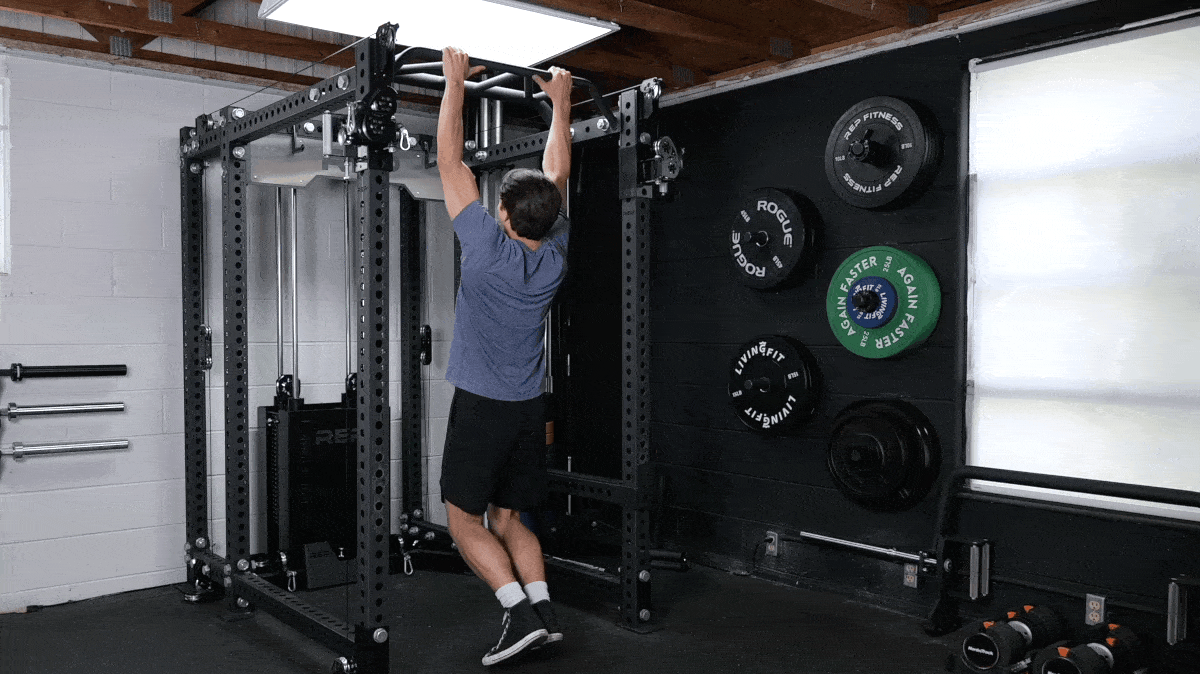
[Read More: The Ultimate Beginner Pull-Up Guide (4-Weeks to Your First Rep!)]
| Equipment Needed | Pull-up bar |
| Muscles Worked | Back, biceps |
| Sets & Reps | 2 x 10-15 for muscle; 3 x 5-7 for strength |
Don’t assume the pull-up is less effective than the other moves on this list because it’s a bodyweight exercise. We like the pull-up precisely because it is simple and accessible, and is one of the best back exercises at home that you don’t need a gym to get value out of.
How To Do It
- Assume an overhead grip on the bar, slightly wider than shoulder-width.
- With the arms relaxed and shoulders elevated up to the ears, contract the core and upper back as you initiate the pull-up.
- Aim to pull your chin to or above the bar level, driving your shoulders away from your ears.
Modifications
- Make it Easier: If you can’t yet do a pull-up, tie a resistance band to the bar and place the free end around your feet to give you some extra help. You can also use an assisted pull-up machine.
- Make it Harder: Add weight to your pull-ups by using a dip belt or by holding a dumbbell between your knees or feet.
3. Bent-Over Barbell Row
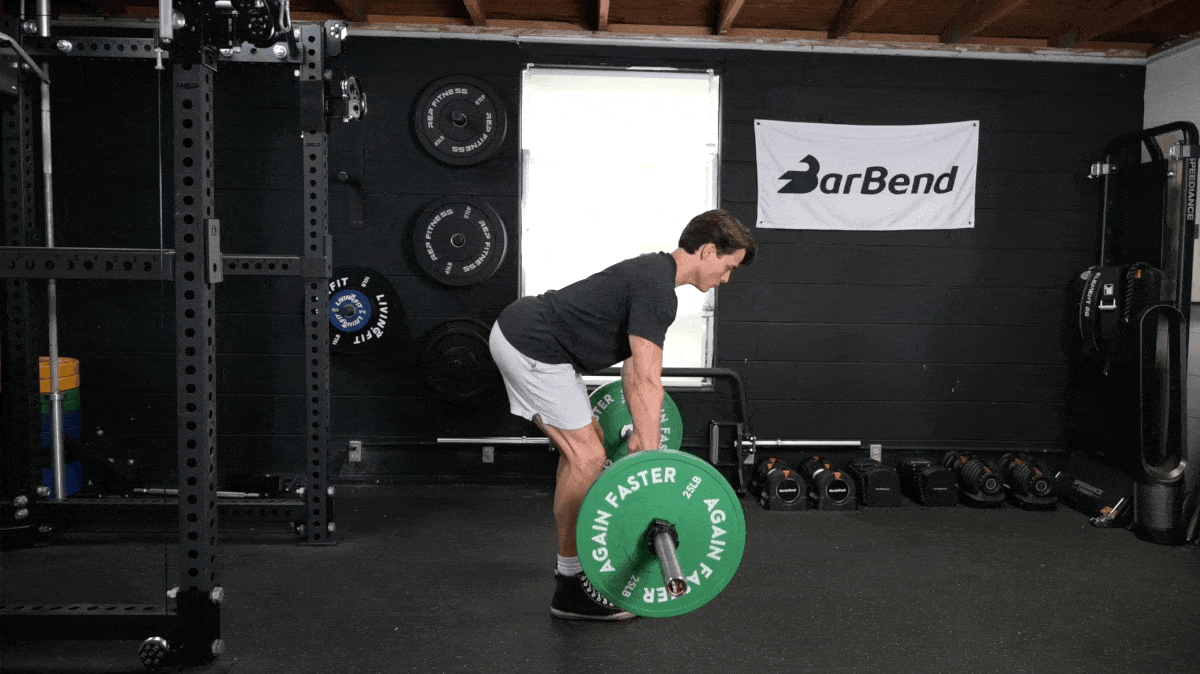
| Equipment Needed | Barbell, weight plates, barbell collars |
| Muscles Worked | Back, biceps, forearms |
| Sets & Reps | 2 x 10-15 for muscle; 4 x 6 for strength |
The bent-over barbell row hits all the major players in your back — the lats, mid traps, and rhomboids. By hinging at your hips to row the weight to your stomach, this barbell back exercise engages your entire posterior chain, including your hamstrings, glutes, and spinal erectors.
How To Do It
- Set up as you would for your deadlift by standing feet shoulder-width apart in front of a loaded barbell.
- Hinge at the hips until your torso is about parallel to the floor.
- Grab the barbell with a grip that’s a bit wider than your typical deadlift grip.
- Lean back, so your weight is on your heels, and row the barbell, leading the pull with your elbow until it touches around your belly button.
Modifications
- Make it Easier: If your lower back feels strained, try a chest-supported row (see the next movement) or simply reduce the weight on the bar.
- Make it Harder: Add more weight to the barbell or perform more reps.
4. Chest-Supported Row

| Equipment Needed | Adjustable weight bench, dumbbells |
| Muscles Worked | Back, biceps, forearms |
| Sets & Reps | 3 x 12 |
The chest support is the critical element of this row variation: This move isolates your back muscles so you can activate them without stressing your hips or utilizing momentum to cheat, says Dickson.
“I’ve used this movement in the past to assist clients that cannot load their lower backs,” he notes, mentioning that it’s also a regular inclusion in his own workout plans.
How To Do It
- Set a weight bench to a 45-degree incline and lay face down so your chest and stomach are supported.
- Grab a dumbbell in each hand and then row them to your sides until your elbows pass your torso.
- Slowly lower the weight under control.
Modifications
- Make it Easier: Adjust the angle of the bench to fit your level of comfort. A steeper incline is easier, but will shift emphasis from your lats to your upper back.
- Make it Harder: Aside from using more weight, you can perform seal rows, which take leg drive out of the equation so you’re rowing strictly with your back muscles.
5. Dumbbell Row
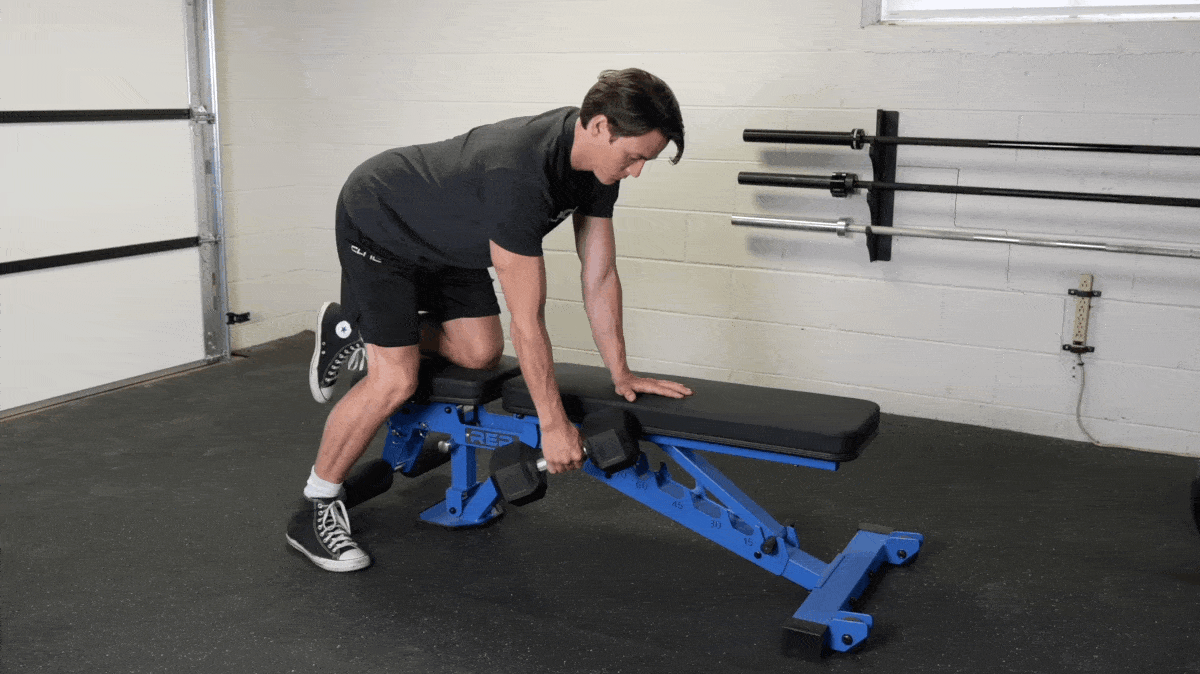
[Read More: The 8 Best Kettlebell Back Exercises to Build Your Back Without a Barbell]
| Equipment Needed | Adjustable weight bench, dumbbells |
| Muscles Worked | Back, biceps, forearms |
| Sets & Reps | 3 x 12-15 |
The dumbbell row, or the single-arm dumbbell row in this instance, can increase your upper back strength, supplement hypertrophy, and correct muscular asymmetries. No matter what your training goals may be, you should probably have at least one single-arm exercise in your rotation.
“Single-arm dumbbell rows are invaluable for improving upper back strength and correcting imbalances. Including unilateral exercises in your workout can enhance your other main lifts,” Masi notes.
[Related: Barbell Row vs. Dumbbell Row — How To Choose]
How To Do It
- Stand next to a bench so that it’s parallel to you.
- Place the same-side hand and knee on it, and firmly plant your other foot onto the floor.
- Reach down with your free hand and grab a dumbbell.
- Keep your back flat and your head in a neutral position.
- Row the dumbbell to your side until your elbow passes your torso.
Modifications
- Make it Easier: Opt for a lighter weight. If your grip is an issue, use lifting straps to help you hang onto the dumbbell.
- Make it Harder: Add more weight. You can also assume a staggered stance in front of a dumbbell rack, place one hand on the rack, and pull the dumbbell from the floor. This increases your range of motion and decreases your stability.
6. Lat Pulldown
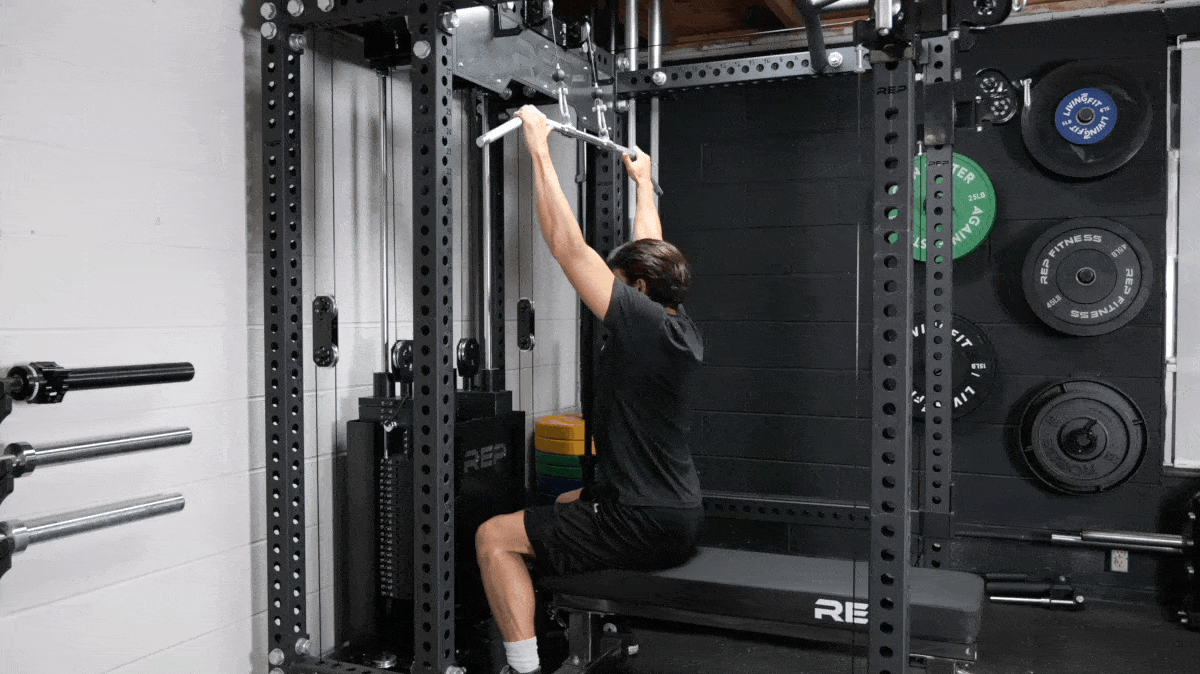
[Read More: The Best Online Workout Programs For Coaching, Cardio, Value, And More]
| Equipment Needed | A lat pulldown station, wide-grip pulldown bar |
| Muscles Worked | Back, biceps |
| Sets & Reps | 4 x 8-10 |
The lat pulldown mimics the motion of a pull-up, making it a great choice for those looking to target their lats and/or work toward a bodyweight pull-up. (It’s also a great movement to perform before pull-ups as a warm-up.) Additionally, the lat pulldown allows for a lot of grip variation. You can grip the bar wide, at shoulder-width, use a natural-grip bar, or even attach a single D-handle to perform pulldowns one arm at a time.
How To Do It
- Set yourself up with your legs under the pad and hands grasping the bar attachment slightly wider than shoulder-width with a pronated (palms facing away) grip.
- With the core tight and the torso upright — or even a little arched — pull the bar down to your chin.
- Slowly resist the weight as you return to the starting position.
Modifications
- Make it Easier: You’ll find that an underhand grip allows you to pull more weight. Pulling with a neutral-grip attachment may also feel more natural and comfortable.
- Make it Harder: Perform tempo reps by explosively pulling the weight down, taking three seconds to return to the starting position, and pausing for one second at the top of each rep.
7. Seated Cable Row
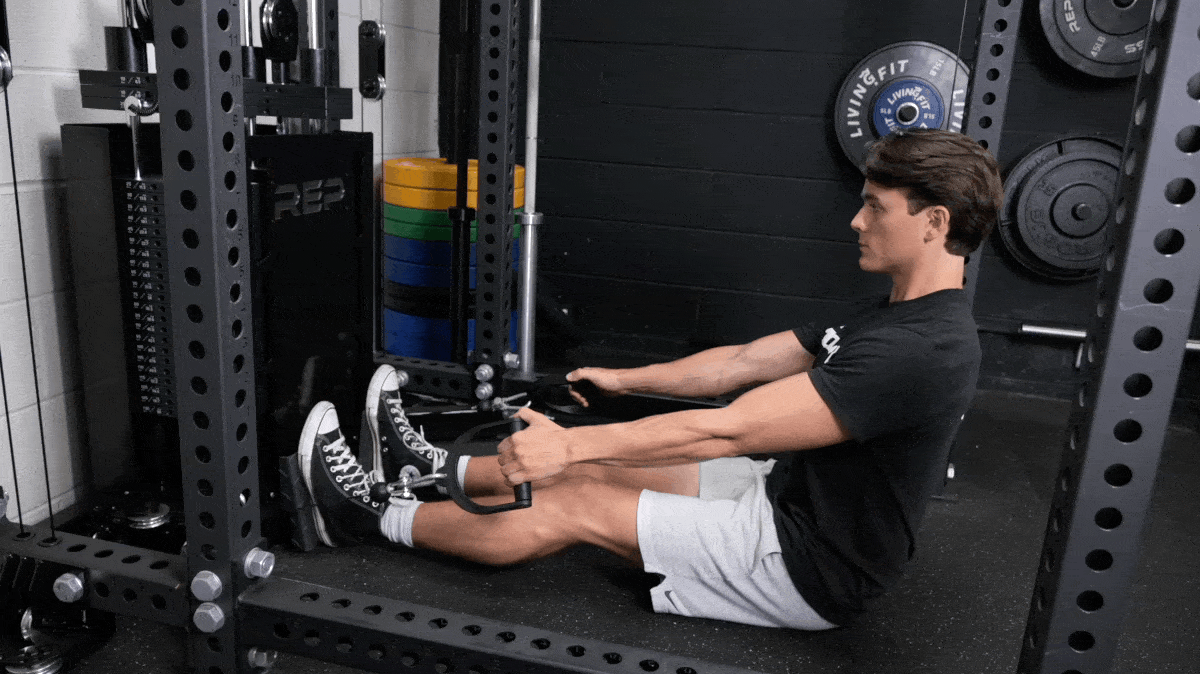
[Read More: 5 At-Home Workouts for Strength, Muscle Growth, Power, and More]
| Equipment Needed | A cable row station OR sit in front of an adjustable cable pulley (as shown) |
| Muscles Worked | Back, biceps |
| Sets & Reps | 3 x 10-12 |
This rowing variation has you pull a shoulder-width neutral grip cable attachment to your torso. While the cable allows you to take advantage of constant resistance, the hand position and arm path allow for a large amount of mechanical tension on your lats. This is a fantastic place to start if you want to emphasize muscle growth.
How To Do It
- Set yourself up in the front of the cable station, with your feet on the foot platform and the hands grasping the attachment with a neutral grip.
- With the core tight and the torso slightly leaned forward at the hip.
- Pull the attachment toward the top of the abdomen.
Modifications
- Make it Easier: Sit a little closer to the machine to reduce your range of motion so you acclimate to the movement pattern.
- Make it Harder: Like the lat pulldown, slow your temp down, taking three to four seconds to lower the weight.
8. Straight-Arm Pulldown
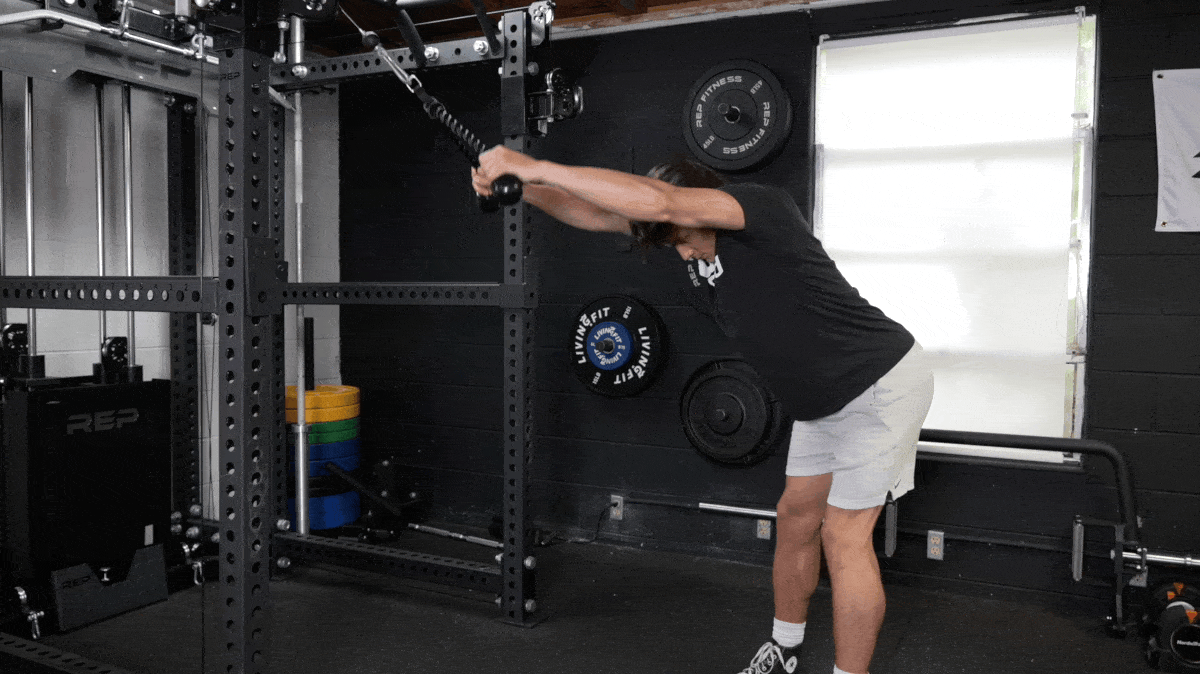
| Equipment Needed | An adjustable cable pulley, a rope attachment |
| Muscles Worked | Back |
| Sets & Reps | 2-3 x 12-15 |
Your back contains a lot of different muscles; isolating them for growth can be quite challenging. The straight-arm pulldown is as close to an “isolation” as you will get for targeting the lats (the largest muscle in your upper back).
“An extended range of motion, constant tension from the cable pulley, and a simple learning curve, makes the straight-arm pulldown a prime muscle-building movement,” Dickson remarks.
How To Do It
- Attach a rope handle, straight bar, or EZ-bar to a cable pulley set at the highest setting.
- Take enough steps back to hinge your torso forward 45 degrees and straighten your arms without any slack in the cable.
- Slightly bend your elbows and then pull the rope to the tops of your thighs.
Modifications
- Make it Easier: Stand closer to the pulley to reduce your overall range of motion.
- Make it Harder: Take a few steps back from the pulley and lean down so your torso is parallel to the ground, and your arms are fully extended. Pull the rope (or bar) to your hips, slightly raising your chest. This is a technique used to enhance the range of motion, creating a harder experience overall.
9. Face Pull
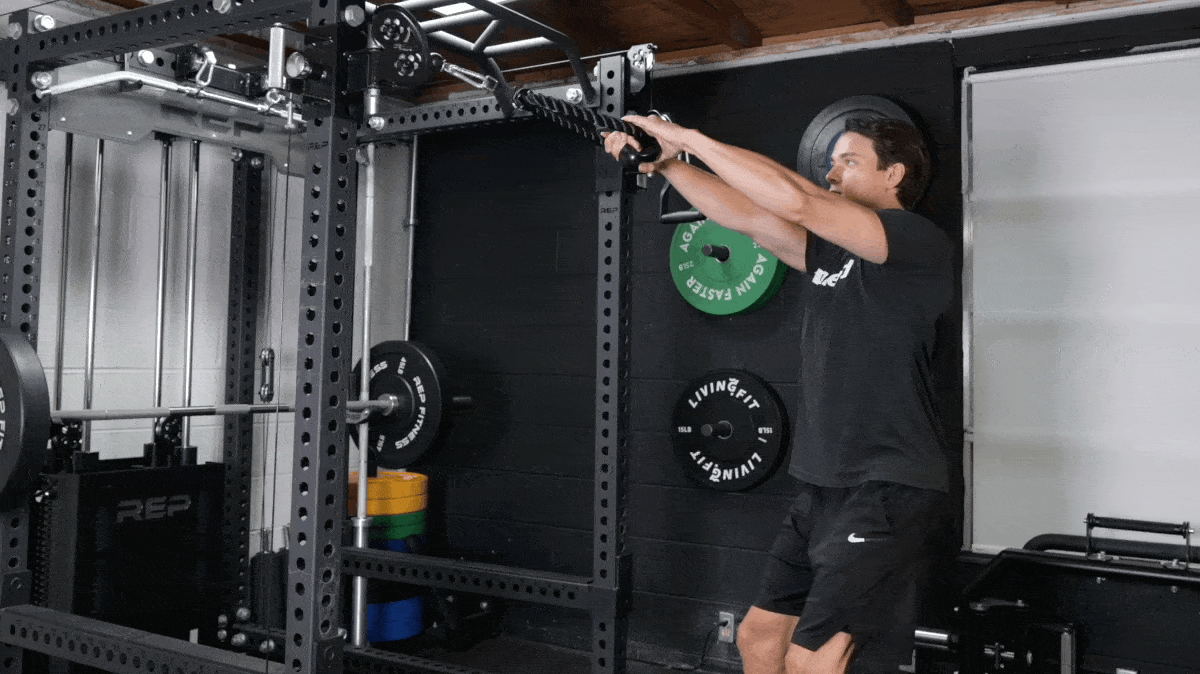
| Equipment Needed | An adjustable cable pulley, a rope attachment |
| Muscles Worked | Back, rear delts |
| Sets & Reps | 2-3 x 15-20 |
It’s not all about strength and mass. Even the small muscles and joints need to be strong and stable to facilitate strong lifts. Enter the face pull, an exercise that contracts your rhomboids, rear delts, and traps to facilitate proper posture and mobility of the shoulder joint.
How To Do It
- Clip a rope attachment to a cable pulley set to the highest setting.
- Grab the rope with both hands, palms facing each other.
- Take a few steps back so there’s tension in the rope.
- Raise your hands so the rope is level with your face.
- Simultaneously pull the rope toward your face and flare your elbows out and back. The movement should look like a front double biceps pose.
Modifications
- Make it Easier: Attach a resistance band to a pole or the upright of a power rack and perform face pulls using that.
- Make it Harder: Add more weight and slow your reps down. Typically, this simple advice will yield your the best results sessions after session.
10. Back Extension

| Equipment Needed | Back extension machine |
| Muscles Worked | Lower back, hamstrings, glutes |
| Sets & Reps | 2 x 12-15 |
Training with lower back exercises isn’t all that sexy, but it’s crucial for improving posture and core strength.
If you’re looking for an exercise to strengthen the lower back, we strongly endorse this movement. The back extension has you simply hinge at your waist, with your legs resting on thigh pads, to engage your erector spinae muscles. Simple, easy, and effective.
“You shouldn’t be afraid of training your lower back directly,” says Dickson. “Your spine is made up of a series of joints, and joints are designed to move.”
How To Do It
- Place your thighs against the pads of a back extension machine, and ensure that your Achilles tendon is right under the ankle pad.
- Cross your arms. Slowly hinge forward until your body forms a 90-degree angle.
- Contract your glutes and hamstrings to come back to the starting position.
Modifications
- Make it Easier: You can reduce the angle of the machine. Though, this movement should be accessible to practically anyone at any fitness level.
- Make it Harder: Hold a weight plate close to your chest.
11. Dumbbell Pullover
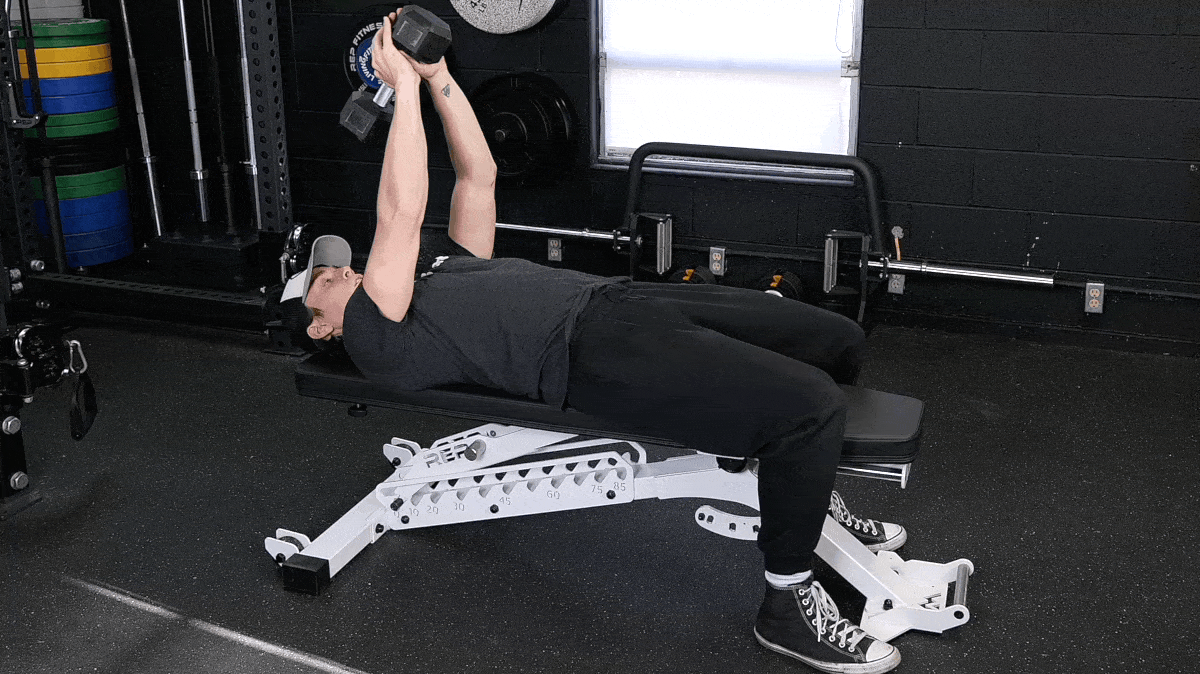
| Equipment Needed | Weight bench, dumbbell |
| Muscles Worked | Back |
| Sets & Reps | 2 x 12-15 |
If your lumbar spine is fried from too many lower back exercises, you can isolate your lats with the pullover without relying on your spine or hips. Dumbbell pullovers are among the few dumbbell back exercises involving only your lats.
How To Do It
- Lie down on the bench on your back with a dumbbell held above your head. Keep your elbows straight but not fully locked out.
- Brace your core and slowly drift your arms back behind your head until they’re in line with your torso.
- Reverse the motion, using your lats to pull your arms back to the starting position.
Modifications
- Make it Easier: Wrap a resistance band around a pole or power rack. Use that for pullovers. The movement will feel easier at the bottom and harder at the top.
- Make it Harder: Use a heavier dumbbell and focus on sinking into the stretch at the bottom of the movement. (Don’t push yourself too hard; stop if you feel pain.)
12. Renegade Row

| Equipment Needed | Exercise mat (optional), dumbbells or kettlebells |
| Muscles Worked | Lats, upper back, core, obliques, brachialis |
| Sets & Reps | 2 x 12-15 |
“Renegade rows aren’t the best back exercise with dumbbells due to the instability, but you can certainly include them if you want to train your back and strengthen your core at the same time,” Dickson remarks. That’s exactly why we like the renegade row; it’s a two-for-one and is far more challenging than it looks at a glance.
“A renegade row may not be the best exercise for back hypertrophy, but it’s a movement that works anti-rotation for your core,” Masi says. “I’d recommend ending your workouts with these or after the main compound work of the day is complete.”
How To Do It
- Place two dumbbells on the floor shoulder-width apart.
- Get down into a push-up position with your legs extended, back straight, and hands on the handles of the weights.
- Brace your core and then row one of the dumbbells up and back into your hip, then lower it down and repeat on the other side.
Modifications
- Make it Easier: To improve your balance while you learn the renegade row, place the opposite knee of your rowing arm on the ground and do all your reps with that arm instead of alternating.
- Make it Harder: Try to limit your ground contact time as you alternate between reps. As soon as one weight touches the floor, start rowing the other.
5 Best Back Workouts
These may be the best back exercises you can do. But how do you put them together into a workout plan that suits your goals? Rest easy; that part is already done.
Back Warm-Up
A well-designed warm-up helps manage injury risk and improves readiness heading into your training session, without generating excessive fatigue. Increased body temperature, an activated (excited) nervous system, and a prepared mental state can help increase readiness for the upcoming day of training.

One of the most effective warm-ups for any muscle group is going to be the exercises you are performing in that day’s training session. Here’s what a comprehensive warm-up protocol might look like, beginning as soon as you set foot in the gym:
- 5-10 minutes on the treadmill, elliptical, stair-stepper, or rowing machine.
- Dead Hang Pull-Up: 3 x 15 seconds.
- Cable or Band Straight-Arm Pulldown: 3 x 20 with light resistance.
- Then, do 1-3 warm-up sets of your first exercise with a light weight.
Back Workout for Strength
This workout focuses on using many of the exercises in this list to help you increase your back strength. This back workout is suited for beginner to intermediate gymgoers:
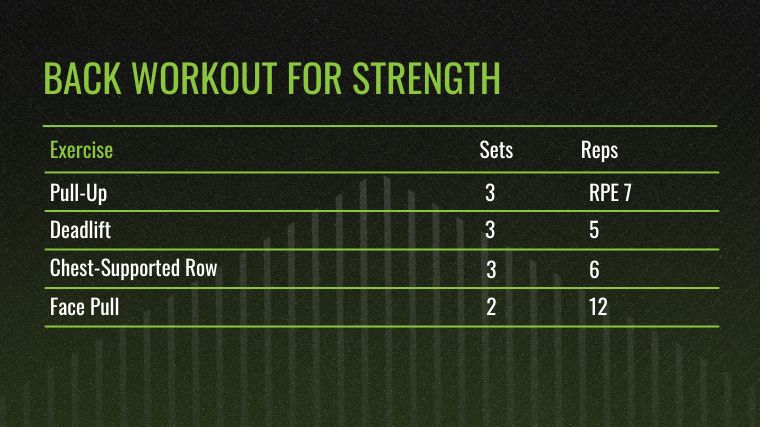
- Pull-Up: 3 x RPE 7
- Deadlift: 3 x 5
- Chest-Supported Row: 3 x 6
- Face Pull: 2 x 12
Back Workout for Mass
Creating hypertrophy with bodybuilding back exercises is all about tension. You need to use different movements that’ll hit different areas of your back, including your middle back, lumbar spine, lats, and upper back region.
“If you want to build muscle, you need a back workout for mass that hits all areas,” recommends Dickson. “It works your back with different equipment, from different angles, and the exercises progress from free-weight compound moves to more stable isolation exercises as you get tired.”
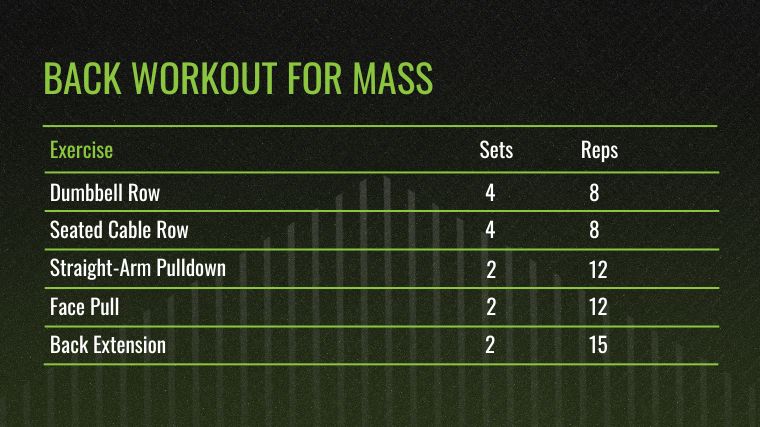
- Dumbbell Row: 4 x 8
- Seated Cable Row: 4 x 8
- Straight-Arm Pulldown: 2 x 12
- Face Pull: 2 x 12
- Back Extension: 2 x 15
Back Workout for Beginners
If you’re new to the gym, your workouts don’t need to be complicated. Two or three simple exercises will do the trick early on. Here’s a straightforward back workout aimed at beginners:

- Bent-Over Barbell Row: 3 x 10
- Lat Pulldown: 3 x 10
- Back Extension: 2 x 15
Back Workout With Dumbbells
Believe it or not, you can get a great back workout in without having to use gym machines or cables. A dumbbell-only back workout will do just fine as long as you select the right exercises:
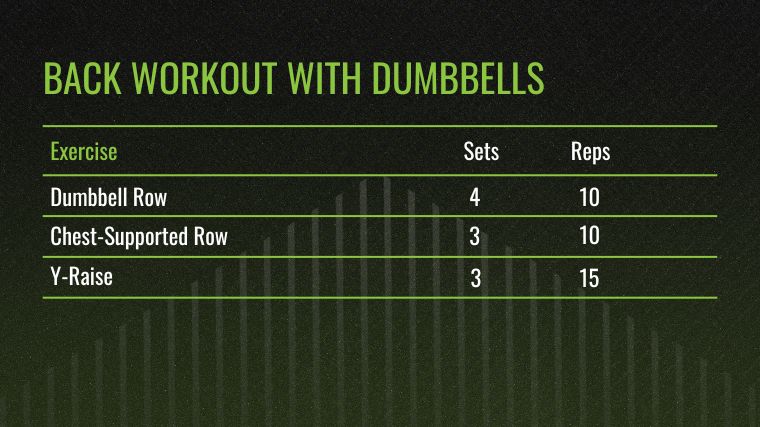
- Dumbbell Row: 4 x 8
- Chest-Supported Row: 3 x 12
- Y-Raise: 3 x 15
At Home Back Workout
Your back is difficult to train if you like to exercise at home — but it’s not impossible. With minimal equipment on-hand such as a stable bar or edge to hang from, you can get a great home back workout in without ever leaving your living room.
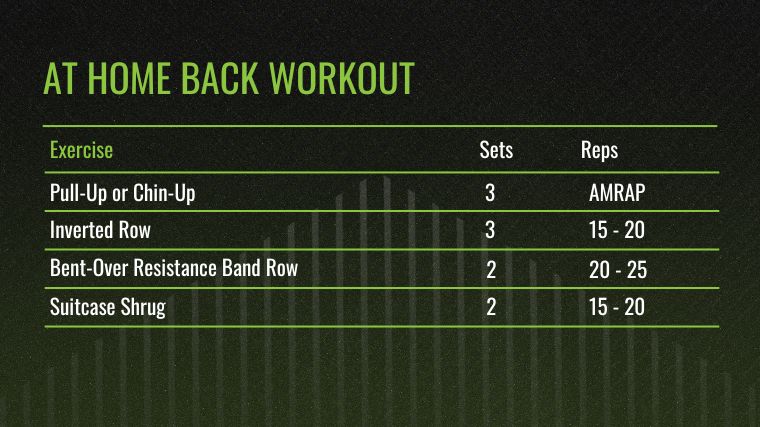
- Pull-Up or Chin-Up: 3 x AMRAP
- Inverted Row: 3 x 15-20
- Bent-Over Resistance Band Row: 2 x 20-25
- Suitcase Shrug: 2 x 15-20
Benefits of Training Your Back
People often refer to your legs as your foundation. That comparison makes sense, but your back is what holds the structure together. Without your lats, rhomboids, traps, and spinal erectors, you’d struggle to even stand up straight, much less work with a heavily-loaded object in your hands like a barbell.
Improved Sport Performance
For athletes, a strong back is paramount. Your back muscles allow you to pull your arms in, and — in conjunction with your core and hips — rotate your torso.
For example, rock climbers will be able to hold a strenuous position for longer and ascend more efficiently. And CrossFit athletes will benefit from the back strength they need to perform pull-ups, snatches, and various carries and climbs.
Carryover to Other Lifts
A strong back can really improve all aspects of your lifting routine. Even if you’re not actively working your back, those muscles still play a role in your weight training. If you’re bench-pressing, a bigger back provides more of a base for you to stabilize on.
The strength of your lats will help give your chest the stability needed to maintain a high amount of tension. When you deadlift, strong back muscles prevent your back from rounding.
Better Posture
Back training does more for you than just helping you perform other exercises better. Since much of the musculature of the back is directly responsible for influencing the spine, a well-developed posterior chain directly impacts your posture as well. Many of these moves are also viable preventative exercises for back pain, as long as you’re not currently injured.
How To Prevent Back Injury and Pain When Training
If you’re worried about performing back workouts because you think you might put your spine at risk, we’d like to help allay those fears. While all forms of physical activity come with some level of inherent risk, you should know that injuries suffered during weight training are less frequent than most traditional sports. (7)
Here are some tips from our expert trainers on how to manage injury risk when training your back:
Frequently Asked Questions
How many back exercises should I do?
Your back contains a large number of different muscles, so you’ll need more than one or two movements to train them all. A good benchmark is to include one upper back focused exercise, one lower back exercise, and two or perhaps even three middle back exercises like rows.
What exercises are good for lower back pain?
If you’re experiencing pain or are injured, you should consult with a physician or physical therapist instead of trying to fix the issue yourself in the gym. That said, you can reduce the likelihood of injuring your spine by strengthening the surrounding muscles. Lower back exercises like the deadlift or back extension are great options here if they don’t cause or worsen any pain.
How do I train all parts of my back?
Your back consists of six main muscles: posterior deltoid, rhomboid, erector spinae, trapezius, rotator cuff, and latissimus dorsi. If you incorporate one to two vertical and horizontal rows each per back training session, you’ll effectively train these muscles.
References
- Jeno SH, Varacallo M. Anatomy, Back, Latissimus Dorsi. [Updated 2020 Aug 13]. In: StatPearls [Internet]. Treasure Island (FL): StatPearls Publishing; 2021.
- Barra-López, M. E., López-de-Celis, C., Pérez-Bellmunt, A., Puyalto-de-Pablo, P., Sánchez-Fernández, J. J., & Lucha-López, M. O. (2020). The supporting role of the teres major muscle, an additional component in glenohumeral stability? An anatomical and radiological study. Medical hypotheses, 141, 109728.
- Ourieff J, Scheckel B, Agarwal A. Anatomy, Back, Trapezius. [Updated 2020 Aug 22]. In: StatPearls [Internet]. Treasure Island (FL): StatPearls Publishing; 2021.
- Farrell C, Kiel J. Anatomy, Back, Rhomboid Muscles. [Updated 2020 Jul 27]. In: StatPearls [Internet]. Treasure Island (FL): StatPearls Publishing; 2021.
- Elzanie A, Varacallo M. Anatomy, Shoulder and Upper Limb, Deltoid Muscle. [Updated 2020 Aug 22]. In: StatPearls [Internet]. Treasure Island (FL): StatPearls Publishing; 2021.
- Modes RJ, Lafci Fahrioglu S. Anatomy, Back. [Updated 2021 Mar 27]. Treasure Island (FL): StatPearls Publishing; 2021.
- Keogh, J. W., & Winwood, P. W. (2017). The Epidemiology of Injuries Across the Weight-Training Sports. Sports medicine (Auckland, N.Z.), 47(3), 479–501.
Featured Image: Studio Peace/Shutterstock
